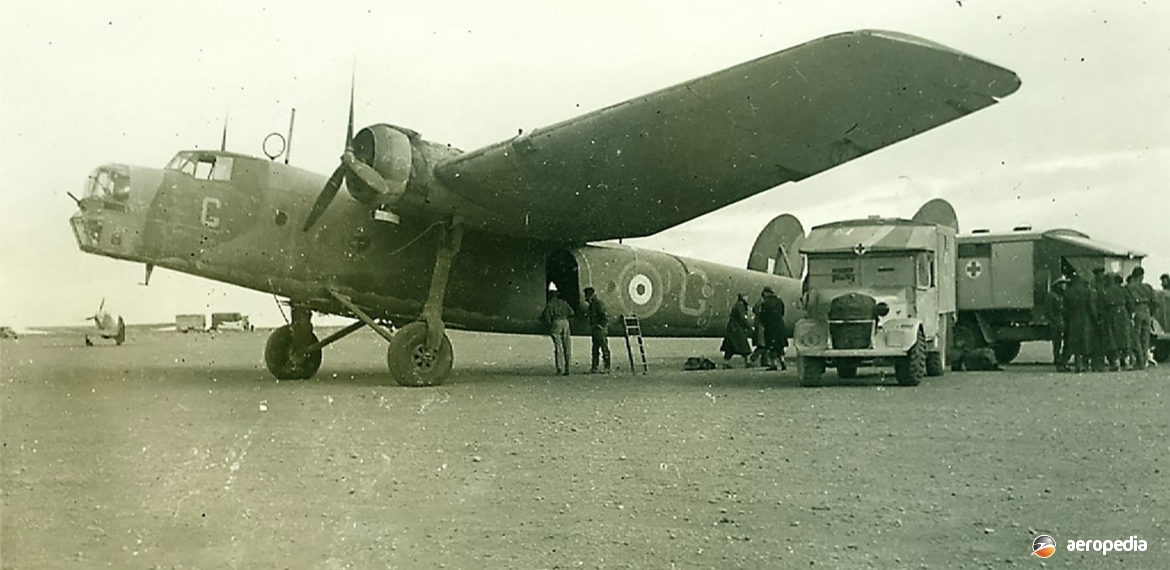Photograph:
Bristol Bombay of No 1 AAU RAAF Coded “C” in the Middle East in 1943 (Eric S Favelle collection)
Country of origin:
United Kingdom
Description:
Medium-range bomber and transport
Power Plant:
Two 753 kw (1,010 hp) Bristol Pegasus XXII nine-cylinder single-row air-cooled radial engines
Specifications:
- Wingspan: 29.75 m (95 ft 9 in)
- Length: 21.1 m (69 ft 3 in)
- Height: 5.95 m (19 ft 6 in)
- Wing area: 124.4 m² (1,340 sq ft)
- Max speed at 1,980 m (6,500 ft): 309 km/h (192 mph)
- Cruising speed at 3,048 m (10,000 ft): 257 km/h (160 mph)
- Time to climb to 4,570 m (15,000 ft): 20 mins
- Service ceiling: 7,620 m (25,000 ft)
- Range with full fuel: 1,420 km (880 miles)
- Range with auxiliary tanks: 3,580 km (2,230 miles)
- Take-off run to 15 m (50 ft): 457 m (1,500 ft)
- Landing run from 15 m (50 ft): 549 m (1,800 ft)
- Empty weight: 6,260 kg (34,800 lb)
- Loaded weight: 9,072 kg (20,000 lb)
Armament:
One 7.7 mm (0.303 in) Vickers K machine gun in nose and tail turrets; max bomb load
907 kg (2,000 lb)
History:
The Bristol Type 130 was designed by the Bristol Aeroplane Company Ltd to meet Air Ministry Specification C.26/31 as a replacement for the Vickers Valentia, and to meet a requirement of the RAF for a bomber able to carry 907 kg (2,000 lb) of bombs with a crew of four; or be used as a transport capable of carrying 24 fully-equipped troops with a crew of four.
The prototype (K3583) was first flown on 23 June 1935 at Filton in south Gloucestershire with two 600 kw (750 hp) Bristol Pegasus III engines, and a production order was placed for 80 aircraft (serials L5808 to L5887), later reduced to 50 aircraft.
The prototype was first shown to the public at the RAF Air Display at Hendon in Greater London in 1935. It later went to the Aeroplane and Armament Experimental Establishment at Martlesham Heath near Ipswich, Suffolk. The first production machine (L5808) was flown in March 1939.
In the nose of the Bristol Bombay was a hydraulically-operated turret with a Lewis machine gun, and the tail gunner was in an open cockpit with a Scarff ring, this later being modified to an enclosed cupola with a single mounted Vickers K gun.
Construction of the type took place at the facility built for Short Bros and Harland & Wolf at Belfast in Northern Ireland, deliveries beginning in April 1939. Examples were supplied to the RAF’s Central Flying School at Upavon in Wiltshire; one went to the School of Army Co-operation at Old Sarum in Salisbury; examples went to Nos 53 and 2 Squadrons RAF; and other examples went to No 10 Flying Training School at Ternhill in Shropshire.
World War II broke out in September 1939 and the following month No 216 Squadron RAF commenced to receive the first of the 39 Bombays, operating the type from a number of airstrips in the Western Desert, including Heliopolis and Cairo West.
Other RAF units to receive the type were Nos 117 and 24 Squadrons. One was supplied to British Overseas Airways Corporation (BOAC) for use as a transport. After the arrival of Douglas C-47 Dakotas in the Meditteranean and African Theatres, Bombays were made available for other work, including transport and aerial ambulance. The type was mainly operated as a transport, supplying units of the Long Range Desert Group, etc.
During their operational career eight were lost to enemy action and four went missing. Civil registrations G-AFYM, G-AFYN and G-AFYO were reserved for three but were never taken up.
No 1 Air Ambulance Unit (No 1 AAU) of the RAAF was formed at Laverton, VIC on 15 February 1941 and was one of a small number of RAAF units designated to operate under RAF control. Amongst other types, it operated the Bombay from February 1943 to February 1944 when the unit was withdrawn from the Western Desert. The unit commenced operations from Gaza in August 1941 initially operating de Havilland DH.86, Bristol Bombay, Lockheed Lodestar and Grumman Goose types. It supported Commonwealth units during the North African campaign, and operated during the Tunisian campaign and the Allied invasion of Sicily. The Bombays were received from No 216 Squadron RAF, which re-equipped with the Vickers Wellington. However, the Bombay was slow, suffered mechanical problems, and made its last evacuation operation in November 1943. The survivors of the type were used to carry medical supplies up until January 1944.
A number of Bombay Mk 1s (L5810 – c/n SH.3; L5811 – c/n SH.4; L5820 – c/n SH.13; L5825 – c/n SH.18; L5827 – c/n SH.20; L5829 – c/n SH.22; L5831 – c/n SH.24; L5838 – c/n SH.31; L5839 – c/n SH.32; L5842 – c/n SH.35; L5844 – c/n SH.37; L5845 – c/n SH.38; and L5851 – c/n SH.43) which had been operated by No 216 Squadron RAF in 1941 were transferred to the operational command of No 1 Australian Air Ambulance Unit. These aircraft retained their desert camouflage, were marked with appropriate red crosses and saw some service in this role. These aircraft were instrumental in evacuating 2,000 casualties from Sicily to North Africa, carrying nursing sisters to Anzio, Italy after the landings there, and were involved in evacuation of casualties during the campaign in Italy.
Bombays L5844 and L5845 continued in service until late 1944 when, having outlived their service life, they were scrapped. L5843 was wrecked when it suffered a tyre-burst on take-off on 1 November 1943. At one stage L5844 was damaged by friendly fire when the red crosses were mistaken for Luftwaffe markings. L5820 was extensively damaged by high winds at Bari in southern Italy on 11 February 1944. No 1 AAU returned to Australia in February 1944 and was disbanded. No Bristol Bombay has survived and no example ever reached the shores of Australia.

